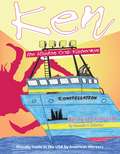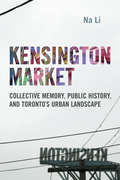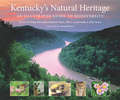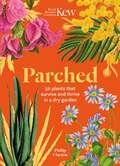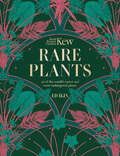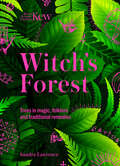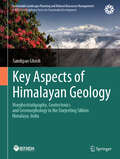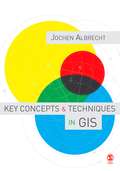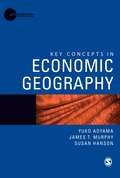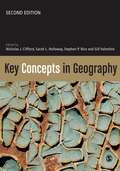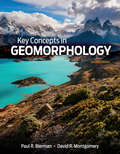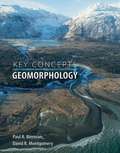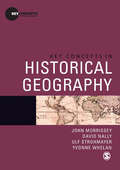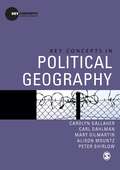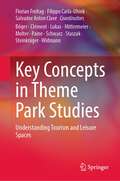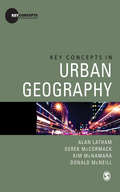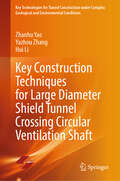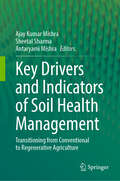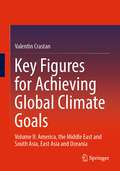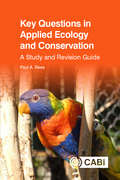- Table View
- List View
Ken the Alaskan Crab Fisherman: Bering Sea King Crab
by Ken BottcherI am truly blessed to be living in the most beautiful place on God's green earth, Valdez, Alaska. Valdez is located in Prince William Sound on Alaska's Gulf coast and is surrounded by natural beauty unequaled, in my opinion, anywhere else on earth. Though my commercial fishing days are far behind me in life, I truly enjoy writing stories I hope inspire children to work hard and follow their dreams.
Kennzahlen zur Erreichung der weltweiten Klimaziele: Band II: Amerika, Nahost und Südasien, Ostasien und Ozeanien
by Valentin CrastanAnalysiert werden die aktuellen Kennzahlen aus der Energiewirtschaft für die geographischen Einheiten Amerika – unterteilt in Nordamerika (Kanada + USA) sowie Mittel- und Südamerika –, Nahost und Südasien sowie Ostasien und Ozeanien. Die wichtigsten energiewirtschaftlichen Indikatoren der einzelnen Regionen und Länder und deren Entwicklung werden in zahlreichen Grafiken und Energieflussdiagrammen veranschaulicht. Darauf basierend empfiehlt der Autor eine Verteilung der zur Begrenzung des Klimawandels notwendigen Emissionsreduktion (für Klimaziel 2 °C und 1,5 °C, mit Perspektive bis 2050).Die in diesem Band behandelten Erdteile verursachen zusammen 77 % der Emissionen. Europa + Eurasien sowie Afrika werden in einem weiteren Band behandelt.
Kensington Market
by Na LiSince the beginning of the twentieth century, Toronto's Kensington Market neighbourhood has been home to a multicultural mosaic of immigrant communities: Jewish, Portuguese, Chinese, South Asian, Caribbean, and many others. Despite repeated transformations, the neighbourhood has never lost its vibrant, close-knit character.In Kensington Market, urban planner and public historian Na Li explores both the Market's dynamic history and the ways in which planners can access the intangible collective memory that helps define neighbourhoods like it around the world. Through examinations of memorable Kensington landmarks such as the Kiev Synagogue, Hyman's Bookstore, and United Bakers Dairy Restaurant, Li traces the connections between the Market's built environment and the experiences of its inhabitants, providing a sterling example of how to map the intangible value of this national landmark.Li's book will be a must-read for those fascinated with this iconic Toronto neighbourhood, as well as anyone with an interest in the role heritage and collective memory can play in urban planning.
Kentucky Agate: State Rock and Mineral Treasure of the Commonwealth
by Roland L. McIntosh Warren H. AndersonThis informative and fully illustrated volume explores the untold story of agate gemstones hidden in Kentucky’s scenic Knobs Region.With their fine grain and rich assortment of colors, agate stones are coveted by collectors and becoming rarer across the globe. Some of the most beautiful specimens in the world have been found in the rugged terrain of eastern Kentucky. In Kentucky Agate, authors Roland L. McIntosh and Warren H. Anderson reveal the beauty and diversity of this sought-after stone with hundreds of color photographs.Kentucky Agate also reveals locations where agate may be found, offering maps of the region surrounding the city of Irvine, Kentucky, including parts of Estill, Powell, Jackson, Menifee, Madison, and Lee counties. With detailed photographs revealing aspects of the rock not visible to the naked eye, this book also provides fascinating information on the history, geology, chemistry, and formation of the mineral.
Kentucky's Natural Heritage: An Illustrated Guide to Biodiversity
by Deborah White Greg Abernathy Ellis L. Laudermilk Marc Evans“[A] beautiful book about a state that has just about everything except a beach: mountains, swamps, rivers, plains, and, of course, the lovely bluegrass.” —Baton Rouge AdvocateKentucky’s abundance of plant and animal life, from the bottomland swamps in the west to the rich Appalachian forests in the east, is extraordinary as well as beautiful. Glades, prairies, forests, wetlands, rivers, and caves form a biologically diverse patchwork that is unique to the state. Kentucky’s Natural Heritage: An Illustrated Guide to Biodiversity provides an essential reference to the remarkable natural history of the commonwealth and is a rallying call for the conservation of this priceless legacy.Kentucky’s ecosystems teem with diverse native species, some of which are found nowhere else in the world. Kentucky’s Natural Heritage brings these sometimes elusive creatures into close view, from black-throated green warblers to lizard skin liverworts. The aquatic systems of the state are home to rainbow darters, ghost crayfish, salamander mussels, and an impressive array of other species that constitute some of the greatest levels of freshwater diversity on the planet.Richly detailed and lavishly illustrated with more than 250 color photos, maps, and charts, Kentucky’s Natural Heritage is the definitive compendium of the commonwealth’s amazing diversity and presents a persuasive argument for the necessity of conservation. Organized by a team from the Kentucky State Nature Preserves Commission, the book is an outgrowth of the agency’s focus on biodiversity protection.“Between its covers, readers will find details of Kentucky’s vanished natural areas and catalogue of the increasingly rare animal, plants and unique habitats that urgently need protection.” —Louisville Courier Journal
Kew - Parched: 50 plants that thrive and survive in a dry garden
by Philip ClaytonDazzling, diverse, durable - discover the remarkable drought-proof plants that flourish in the driest environments.With rainfall unpredictable and summers increasingly hot, plants that survive and thrive in these conditions have become more important than ever. Through expert text and beautiful botanical illustrations from the archives of the Royal Botanic Gardens, Kew, Parched explores the captivating variety that exists in the world of dry plants. From poppies and palms to cypress and cyclamen, this stunning book showcases the incredible species that have become a mainstay of dry gardens around the world.
Kew - Parched: 50 plants that thrive and survive in a dry garden
by Philip ClaytonDazzling, diverse, durable - discover the remarkable drought-proof plants that flourish in the driest environments.With rainfall unpredictable and summers increasingly hot, plants that survive and thrive in these conditions have become more important than ever. Through expert text and beautiful botanical illustrations from the archives of the Royal Botanic Gardens, Kew, Parched explores the captivating variety that exists in the world of dry plants. From poppies and palms to cypress and cyclamen, this stunning book showcases the incredible species that have become a mainstay of dry gardens around the world.
Kew - Rare Plants: The world's unusual and endangered plants
by Royal Botanic Kew Ed Ikin"Some plants are inherently rare, while others become rare through our actions."Rare Plants explores what makes the world's most uncommon plants so exceptional, and by what means they have become so scarce. From highlands to jungles, many of our most extraordinary plants are vanishing at shocking rates, and this exquisitely illustrated book explores 40 of these mysterious species.Featuring stunning archive images and expert insight from the Royal Botanical Gardens, Kew, Rare Plants explores both the beauty and necessity of our endangered plant life.
Kew - Rare Plants: The world's unusual and endangered plants
by Royal Botanic Kew Ed Ikin"Some plants are inherently rare, while others become rare through our actions."Rare Plants explores what makes the world's most uncommon plants so exceptional, and by what means they have become so scarce. From highlands to jungles, many of our most extraordinary plants are vanishing at shocking rates, and this exquisitely illustrated book explores 40 of these mysterious species.Featuring stunning archive images and expert insight from the Royal Botanical Gardens, Kew, Rare Plants explores both the beauty and necessity of our endangered plant life.
Kew - Witch's Forest: Trees in magic, folklore and traditional remedies
by Sandra Lawrence Royal Botanic KewThere is more folklore, mythology and magic associated with our trees and forests than with any other living things.Known throughout the world as dark and wild places where witches make mischief and eerie creatures dwell, forests are also places of sanctuary for the ancient magic and the most enchanting species of trees.Kew: Witch's Forest is a beautifully illustrated, captivating journey through the magical woodland and its stories, from birch broomsticks and the sacred olive, to alder doorways and the Tree of Life.
Kew - Witch's Forest: Trees in magic, folklore and traditional remedies
by Sandra Lawrence Royal Botanic KewThere is more folklore, mythology and magic associated with our trees and forests than with any other living things.Known throughout the world as dark and wild places where witches make mischief and eerie creatures dwell, forests are also places of sanctuary for the ancient magic and the most enchanting species of trees.Kew: Witch's Forest is a beautifully illustrated, captivating journey through the magical woodland and its stories, from birch broomsticks and the sacred olive, to alder doorways and the Tree of Life.
Key Aspects of Himalayan Geology: Morphostratigraphy, Geotectonics and Geomorphology in the Darjeeling Sikkim Himalaya, India (Sustainable Landscape Planning and Natural Resources Management)
by Sandipan GhoshThis book serves as a ready reference book for anyone who is interested in the Himalayan geology and apprises the readers with the latest findings. The Himalayan syntaxes compose about one-third of the India-Asia collision zone and encompass a substantial part of the crustal deformation that occurs within the system. The Darjeeling Sikkim Himalaya (DSH) marks the beginning of the Eastern Himalaya, which is the most active orogenic zone, coupled with variable seismicity. It is located between Bhutan to the east and Nepal to the west. In the west, Sikkim shares Kanchenjunga, Earth's third highest mountain, with Nepal, while the ridge line forming Sikkim's eastern border flanks the Yadong-Gulu rift graben. DSH, craved by the river system of Tista, is a large geodynamic laboratory of nature where orogen is still in youth to early mature phases of evolution. Giant-scale endogenous turmoil thoroughly overhauled terrain mostly within the confines of distinct belts or divisions and spectacularly uplifted the terrain in superlative terms. Resting on the foundation of structure, tectonics, geomorphology, stratigraphy, and evolution, the wings of geology extend much further. Several books, mostly having regional approaches of different scales, have been written on the Himalayan geology with specified intentions. Geological Aspects of the DSH is based on more than direct references and succinctly opens a gateway to variable aspects of mineral study, active tectonics, crustal deformation, tectono-stratigraphy, seismicity, sedimentary geology, palaeontology, landslides, and tectonic geomorphology. The book apprises the readers with the latest findings. The book is addressed to university students for their academic needs and to those who are willing to work in Himalayan terrain. The large number of topics covered in this book is hardly available in any other single book so far. Anyone interested in the geology of the Himalaya might use the book as a quick reference. Different Dimensions of Geology and Geomorphology are described in nine key chapters.
Key Concepts and Techniques in GIS
by Jochen AlbrechtKey Concepts and Techniques in GIS is a concise overview of the fundamental ideas that inform geographic information science. It provides detailed descriptions of the concepts and techniques that anyone using GIS software must fully understand to analyse spatial data. Short and clearly focussed chapters provide explanations of: spatial relationships and spatial data the creation of digital data, the use and access of existing data, the combination of data the use of modelling techniques and the essential functions of map algebra spatial statistics and spatial analysis geocomputation - including discussion of neural networks, cellular automata, and agent-based modelling Illustrated throughout with explanatory figures, the text also includes a glossary, cross referenced to discussion in the text. Written very much from a user′s perspective, Key Concepts and Techniques in GIS is highly readable refresher course for intermediate level students and practitioners of GIS in the social and the natural sciences.
Key Concepts in Economic Geography (Key Concepts in Human Geography)
by Yuko Aoyama Susan Hanson James T Murphy"A comprehensive and highly readable review of the conceptual underpinnings of economic geography. Students and professional scholars alike will find it extremely useful both as a reference manual and as an authoritative guide to the numerous theoretical debates that characterize the field." - Allen J. Scott, University of California "Guides readers skilfully through the rapidly changing field of economic geography... The key concepts used to structure this narrative range from key actors and processes within global economic change to a discussion of newer areas of research including work on financialisation and consumption. The result is a highly readable synthesis of contemporary debates within economic geography that is also sensitive to the history of the sub-discipline." - Sarah Hall, University of Nottingham "The nice thing about this text is that it is concise but with depth in its coverage. A must have for any library, and a useful desk reference for any serious student of economic geography or political economy." - Adam Dixon, Bristol University Organized around 20 short essays, Key Concepts in Economic Geography provides a cutting edge introduction to the central concepts that define contemporary research in economic geography. Involving detailed and expansive discussions, the book includes: An introductory chapter providing a succinct overview of the recent developments in the field. Over 20 key concept entries with comprehensive explanations, definitions and evolutions of the subject. Extensive pedagogic features that enhance understanding including figures, diagrams and further reading. An ideal companion text for upper-level undergraduate and postgraduate students in economic geography, the book presents the key concepts in the discipline, demonstrating their historical roots and contemporary applications to fully understand the processes of economic change, regional growth and decline, globalization, and the changing locations of firms and industries. Written by an internationally recognized set of authors, the book is an essential addition to any geography student′s library.
Key Concepts in Geography
by Gill Valentine Nicholas J. Clifford Sarah L. Holloway Stephen P. RiceIncluding ten new chapters on nature, globalization, development and risk, and a new section on practicing geography, this is a completely revised and updated edition of the best-selling, standard student resource. Key Concepts in Geography explains the key terms - space, time, place, scale, landscape - that define the language of geography. It is unique in the reference literature as it provides - in one volume - concepts from both human geography and physical geography; especially relevant now that environment is so critical to our understanding of geography. Four introductory chapters on different intellectual traditions in geography situate and introduce the entries on the key concepts. Each entry then comprises a short definition, a summary of the principal arguments, a substantive 5,000-word discussion, the use of real-life examples, and annotated notes for further reading. Written in an accessible way - by established figures in the discipline - the definitions provide thorough explanations of key geographical concepts. Each discussion provides references to, and summaries of, the key literature; as well as an examination of the history and use of each concept, illustrated with everyday examples. Key Concepts in Geography is a comprehensive overview of the all the core concepts that undergraduates of geography must understand to complete their degree.
Key Concepts in Geomorphology
by David Montgomery Paul BiermanDeveloped with extensive community involvement and support from the US National Science Foundation, it is about our planet’s dynamic surface, a place where Earth and atmosphere meet and life thrives.Key Concepts in Geomorphology takes an integrative science approach that applies principles of physics, chemistry, biology, and mathematics in the understanding of Earth surface processes and the evolution of topography over short and long timescales to solve problems important to people and societies. The authors also hone in on practical applications, showing how scientists are using geomorphological research to tackle critical societal issues (natural disaster response, safer infrastructure, protecting species, and more).
Key Concepts in Geomorphology
by David R. Montgomery Paul R. BiermanWritten for introductory geomorphology courses, Key Concepts in Geomorphology offers an integrative, applications-centered approach to the study of the Earth’s dynamic surface. Bierman and Montgomery draw from the fields of physics, chemistry, biology, and mathematics to help students get a basic understanding of Earth surface processes and the evolution of topography over short and long timescales. The authors also hone in on practical applications, showing how scientists are using geomorphological research to tackle critical societal issues (natural disaster response, safer infrastructure, protecting species, and more).
Key Concepts in Historical Geography (Key Concepts in Human Geography)
by Ulf Strohmayer Yvonne Whelan John Morrissey David NallyKey Concepts in Historical Geography forms part of an innovative set of companion texts for the Human Geography sub-disciplines. Organized around 24 short essays, it provides a cutting edge introduction to the central concepts that define contemporary research in Historical Geography. Involving detailed and expansive discussions, the book includes: An introductory chapter providing a succinct overview of the recent developments in the field 24 key concepts entries with comprehensive explanations, definitions and evolutions of the subject Extensive pedagogic features that enhance understanding including a glossary, figures, diagrams and further reading Key Concepts in Historical Geography is an ideal companion text for upper-level undergraduate and postgraduate students and covers the expected staples from the discipline - from people, space and place to colonialism and geopolitics - in an accessible style. Written by an internationally recognized set of authors, it is is an essential addition to any geography student's library.
Key Concepts in Political Geography (Key Concepts in Human Geography)
by Carolyn Gallaher Carl T. Dahlman Mary Gilmartin Alison Mountz Peter ShirlowThis is a new kind of textbook that forms part of an innovative set of companion texts for the human geography subdisciplines. Organized around 20 short essays, Key Concepts in Political Geography provides a cutting-edge introduction to the central concepts that define contemporary research in the field. Involving detailed yet expansive discussions, the book includes: • an introductory chapter providing a succinct overview of the recent developments in the field • over 20 key concept entries covering the expected staples of the sub-discipline, such as nationalism, territoriality, scale and political-economy, as well as relatively new arrivals to the field including the other, anti-statism, gender, and post-conflict • extensive pedagogic features that enhance understanding including a glossary, figures, diagrams and further reading.
Key Concepts in Theme Park Studies: Understanding Tourism and Leisure Spaces
by Filippo Carlà-Uhink Florian Freitag Salvador Anton ClavéThis book offers a comprehensive, multidisciplinary introduction to theme parks and the field of theme park studies. It identifies and discusses relevant economic, social, and cultural as well as medial, historical, and geographical aspects of theme parks worldwide, from the big international theme park chains to smaller, regional, family-operated parks. The book also describes the theories and methods that have been used to study theme parks in various academic disciplines and reviews the major contexts in which theme parks have been studied. By providing the necessary backgrounds, theories, and methods to analyze and understand theme parks both as a business field and as a socio-cultural phenomenon, this book will be a great resource to students, academics from all disciplines interested in theme parks, and professionals and policy-makers in the leisure and entertainment as well as the urban planning sector.
Key Concepts in Urban Geography (Key Concepts in Human Geography)
by Derek Mccormack Kim Mcnamara Donald Mcneill Dr Alan LathamKey Concepts in Urban Geography is a new kind of textbook that forms part of an innovative set of companion texts for the human geography subdisciplines. Organized around 20 short essays, Key Concepts in Urban Geography provides a cutting-edge introduction to the central concepts that define contemporary research in urban geography. Involving detailed and expansive discussions, the book includes: * an introductory chapter providing a succinct overview of the recent developments in the field * over 20 key concept entries with comprehensive explanations, definitions and evolutions of the subject * extensive pedagogic features that enhance understanding including a glossary, figures, diagrams and further reading. This is an ideal companion text for upper-level undergraduate and postgraduate students in urban geography and covers the expected staples of the subdiscipline from global cities and urban nature to transnational urbanism and virtuality.
Key Construction Techniques for Large Diameter Shield Tunnel Crossing Circular Ventilation Shaft (Key Technologies for Tunnel Construction under Complex Geological and Environmental Conditions)
by Hui Li Zhanhu Yao Yazhou ZhangBased on the construction of Nanjing Weisan Road Yangtze River Tunnel, this book comprehensively introduces the new technology of large-diameter shield tunnel construction crossing circular air shafts. It focuses on four aspects: the construction technology of super-deep circular air shaft foundation pit retaining structure in the sensitive environment near the river, underwater excavation and underwater massive concrete sealing bottom construction technology, adaptive improvement of TBM and construction technology of crossing air shaft, and control technology of super-deep foundation pit stability during the process of conversion. This book combines theory with practice, and can provide reference for shield engineering construction. It can also be used as a reference for engineering and technical personnel, researchers, teachers and students in related majors in colleges who are engaged in shield tunnel engineering.
Key Drivers and Indicators of Soil Health Management: Transitioning from Conventional to Regenerative Agriculture
by Ajay Kumar Mishra Sheetal Sharma Antaryami MishraThis book explores the crucial transition from conventional to regenerative agriculture practices, focusing on the key drivers and indicators of soil health management. It provides knowledge to implement sustainable agricultural systems that prioritize soil health and foster the transition toward regenerative practices. This book delves into the principles and concepts of soil health, the challenges and limitations of conventional agriculture, the assessment of soil health through various indicators, and the importance of cover crops, crop rotation, conservation tillage, nutrient management, and water conservation practices. It also addresses the role of soil biodiversity, policy frameworks, and scaling up regenerative agriculture, providing practical strategies and case studies. The target audience for this book ranges from students and researchers to policymakers and large-scale farmers. Farmers will benefit from the practical insights and strategies presented, and policymakers and agricultural organizations can gain valuable knowledge on the drivers and policy frameworks supporting sustainable agriculture and soil health management. This book explores the crucial transition from conventional to regenerative agriculture practices, focusing on the key drivers and indicators of soil health management. It provides knowledge to implement sustainable agricultural systems that prioritize soil health and foster the transition toward regenerative practices. This book delves into the principles and concepts of soil health, the challenges and limitations of conventional agriculture, the assessment of soil health through various indicators, and the importance of cover crops, crop rotation, conservation tillage, nutrient management, and water conservation practices. It also addresses the role of soil biodiversity, policy frameworks, and scaling up regenerative agriculture, providing practical strategies and case studies. The target audience for this book ranges from students and researchers to policymakers and large-scale farmers. Farmers will benefit from the practical insights and strategies presented, and policymakers and agricultural organizations can gain valuable knowledge on the drivers and policy frameworks supporting sustainable agriculture and soil health management.
Key Figures for Achieving Global Climate Goals: Volume II: America, the Middle East and South Asia, East Asia and Oceania
by Valentin CrastanThis volume analyses the energy industry for the following geographical units: America – divided into North America (Canada + USA) and Central and South America –, the Middle East and South Asia, East Asia and Oceania. The key energy-economic indicators for each region and country and their development, are illustrated in numerous graphs and energy flow diagrams. Based on this analysis, the author recommends a distribution of emission reductions necessary to limit climate change (for the 2°C and 1.5°C climate goals, with a perspective up to 2050).The continents covered in this volume collectively account for 77% of emissions. Europe + Eurasia and Africa will be addressed in volume I.
Key Questions in Applied Ecology and Conservation: A Study and Revision Guide (Key Questions)
by Dr Paul ReesAn understanding of applied ecology and conservation is an important requirement of a wide range of programmes of study including applied biology, ecology, environmental science and wildlife conservation. This book is a study and revision guide for students following such programmes. It contains 600 multiple-choice questions (and answers) set at three levels - foundation, intermediate and advanced - and grouped into 10 major topic areas: History and foundations of applied ecology and conservation Environmental pollution and perturbations Wildlife and conservation biology Restoration biology and habitat management Agriculture, forestry and fisheries management Pest, weed and disease management Urban ecology and waste management Global environmental change Environmental and wildlife law and policy Environmental assessment, monitoring and modelling The book has been produced in a convenient format so that it can be used at any time in any place. It allows the reader to learn and revise the meaning of terms used in applied ecology and conservation, study the effects of pollution on ecosystems, the management, conservation and restoration of wildlife populations and habitats, urban ecology, global environmental change, environment law and much more. The structure of the book allows the study of one topic area at a time, progressing through simple questions to those that are more demanding. Many of the questions require students to use their knowledge to interpret information provided in the form of graphs, data or photographs.
